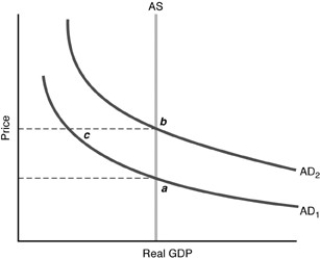Multiple Choice

-Refer to the above figure.The rational expectations hypothesis implies that an anticipated increase in aggregate demand from  to
to  will
will
A) move the economy from c to b.
B) move the economy from a to b.
C) move the economy from a to c.
D) will shift the aggregate supply (AS) curve to the right.
Correct Answer:

Verified
Correct Answer:
Verified
Q7: Suppose the economy has been experiencing zero
Q29: The short run aggregate supply (SRAS)curve shifts
Q66: Real business cycles could be a result
Q129: There is greater support for passive policymaking
Q177: An unexpected decrease in aggregate demand<br>A) causes
Q184: When "stagflation" occurs<br>A) the economy experiences higher
Q190: At one time, many economists believed that<br>A)the
Q260: When workers and employers correctly anticipate the
Q288: <img src="https://d2lvgg3v3hfg70.cloudfront.net/TB2747/.jpg" alt=" -In the above
Q297: <img src="https://d2lvgg3v3hfg70.cloudfront.net/TB5016/.jpg" alt=" -Refer to the